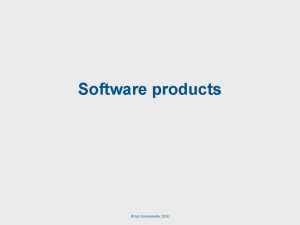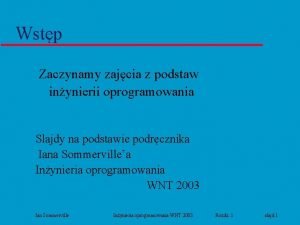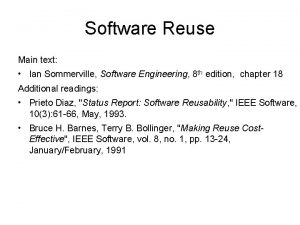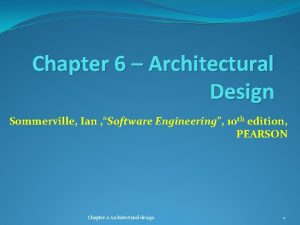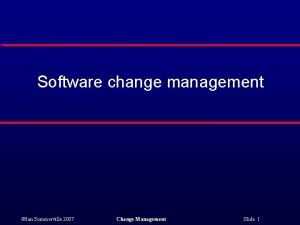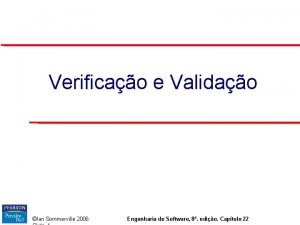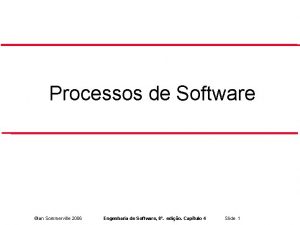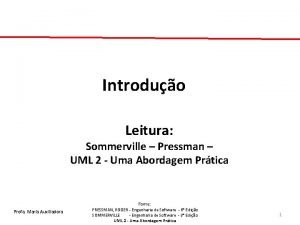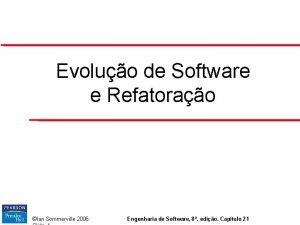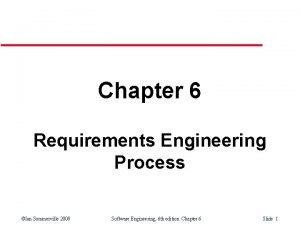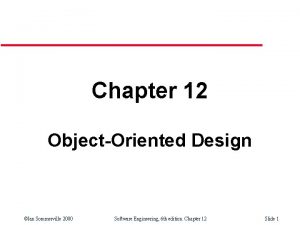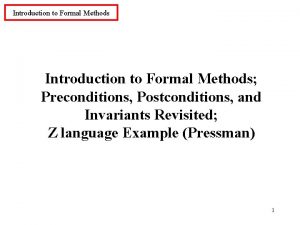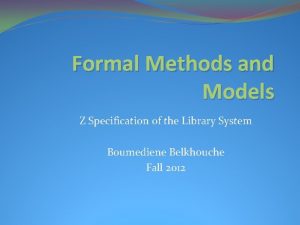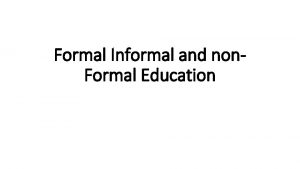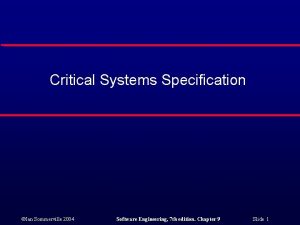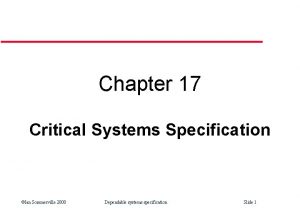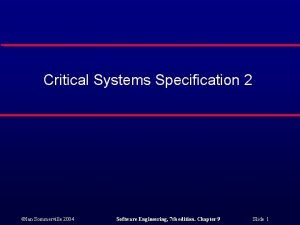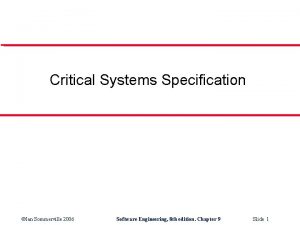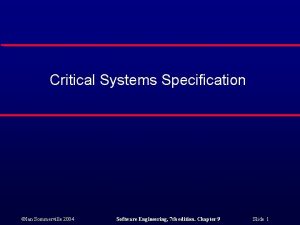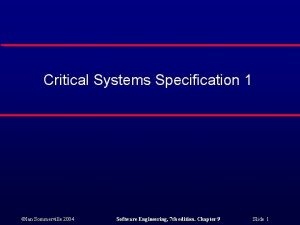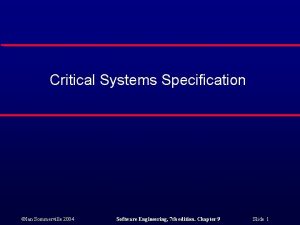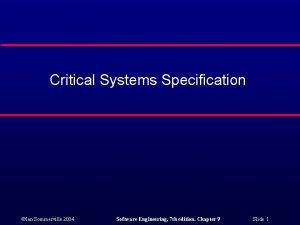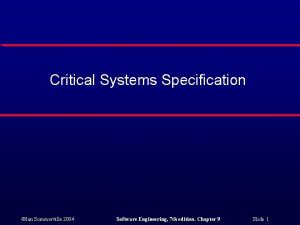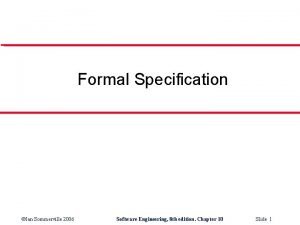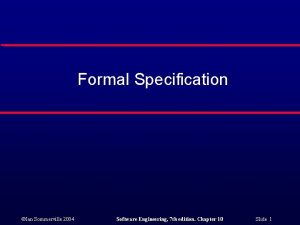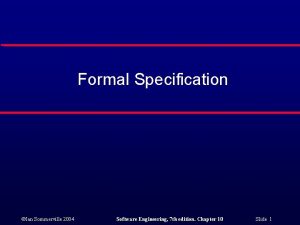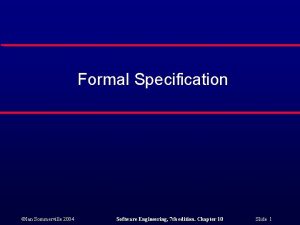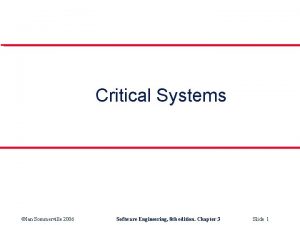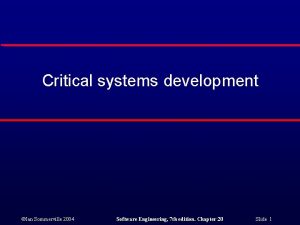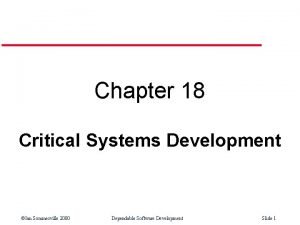Critical Systems Specification 3 Formal Specification Ian Sommerville























- Slides: 23

Critical Systems Specification 3 Formal Specification ©Ian Sommerville 2004 Software Engineering, 7 th edition. Chapter 10 Slide 1

Objectives l l To explain why formal specification techniques help discover problems in system requirements To illustrate model-based specification using a simple example ©Ian Sommerville 2004 Software Engineering, 7 th edition. Chapter 10 Slide 2

Formal methods l l l Formal specification is part of a more general collection of techniques that are known as ‘formal methods’. These are all based on mathematical representation and analysis of software. Formal methods include • • Formal specification; Specification analysis and proof; Transformational development; Program verification. ©Ian Sommerville 2004 Software Engineering, 7 th edition. Chapter 10 Slide 3

Acceptance of formal methods l Formal methods have not become mainstream software development techniques as was once predicted • • Other software engineering techniques have been successful at increasing system quality. Hence the need formal methods has been reduced; Market changes have made time-to-market rather than software with a low error count the key factor. Formal methods do not reduce time to market; The scope of formal methods is limited. They are not wellsuited to specifying and analysing user interfaces and user interaction; Formal methods are still hard to scale up to large systems. ©Ian Sommerville 2004 Software Engineering, 7 th edition. Chapter 10 Slide 4

Use of formal methods l l l The principal benefits of formal methods are in reducing the number of faults in systems. Consequently, their main area of applicability is in critical systems engineering. There have been several successful projects where formal methods have been used in this area. In this area, the use of formal methods is most likely to be cost-effective because high system failure costs must be avoided. ©Ian Sommerville 2004 Software Engineering, 7 th edition. Chapter 10 Slide 5

Specification in the software process l l l Specification and design are inextricably intermingled. Architectural design is essential to structure a specification and the specification process. Formal specifications are expressed in a mathematical notation with precisely defined vocabulary, syntax and semantics. ©Ian Sommerville 2004 Software Engineering, 7 th edition. Chapter 10 Slide 6

Specification and design ©Ian Sommerville 2004 Software Engineering, 7 th edition. Chapter 10 Slide 7

Specification in the software process ©Ian Sommerville 2004 Software Engineering, 7 th edition. Chapter 10 Slide 8

Use of formal specification l l Formal specification involves investing more effort in the early phases of software development. This reduces requirements errors as it forces a detailed analysis of the requirements. Incompleteness and inconsistencies can be discovered and resolved. Hence, savings as made as the amount of rework due to requirements problems is reduced. ©Ian Sommerville 2004 Software Engineering, 7 th edition. Chapter 10 Slide 9

Cost profile l The use of formal specification means that the cost profile of a project changes • • There are greater up front costs as more time and effort are spent developing the specification; However, implementation and validation costs should be reduced as the specification process reduces errors and ambiguities in the requirements. ©Ian Sommerville 2004 Software Engineering, 7 th edition. Chapter 10 Slide 10

Development costs with formal specification ©Ian Sommerville 2004 Software Engineering, 7 th edition. Chapter 10 Slide 11

Specification techniques l Algebraic specification • l The system is specified in terms of its operations and their relationships. Model-based specification • The system is specified in terms of a state model that is constructed using mathematical constructs such as sets and sequences. Operations are defined by modifications to the system’s state. ©Ian Sommerville 2004 Software Engineering, 7 th edition. Chapter 10 Slide 12

Behavioural specification l l l I focus on model-based specification here and illustrate it using an example. These slides illustrarte what a specification looks like - you do not need to understand it in detail. Model-based specification exposes the system state and defines the operations in terms of changes to that state. The Z notation is a mature technique for modelbased specification. It combines formal and informal description and uses graphical highlighting when presenting specifications. ©Ian Sommerville 2004 Software Engineering, 7 th edition. Chapter 10 Slide 13

The structure of a Z schema ©Ian Sommerville 2004 Software Engineering, 7 th edition. Chapter 10 Slide 14

Modelling the insulin pump l The Z schema for the insulin pump declares a number of state variables including: • • Input variables such as switch? (the device switch), Insulin. Reservoir? (the current quantity of insulin in the reservoir) and Reading? (the reading from the sensor); Output variables such as alarm! (a system alarm), display 1!, display 2! (the displays on the pump) and dose! (the dose of insulin to be delivered). ©Ian Sommerville 2004 Software Engineering, 7 th edition. Chapter 10 Slide 15

Schema invariant l l Each Z schema has an invariant part which defines conditions that are always true. For the insulin pump schema it is always true that • • • The dose must be less than or equal to the capacity of the insulin reservoir; No single dose may be more than 4 units of insulin and the total dose delivered in a time period must not exceed 25 units of insulin. This is a safety constraint; display 2! shows the amount of insulin to be delivered. ©Ian Sommerville 2004 Software Engineering, 7 th edition. Chapter 10 Slide 16

Insulin pump schema ©Ian Sommerville 2004 Software Engineering, 7 th edition. Chapter 10 Slide 17

State invariants ©Ian Sommerville 2004 Software Engineering, 7 th edition. Chapter 10 Slide 18

The dosage computation l l The insulin pump computes the amount of insulin required by comparing the current reading with two previous readings. If these suggest that blood glucose is rising then insulin is delivered. Information about the total dose delivered is maintained to allow the safety check invariant to be applied. Note that this invariant always applies - there is no need to repeat it in the dosage computation. ©Ian Sommerville 2004 Software Engineering, 7 th edition. Chapter 10 Slide 19

RUN schema (1) ©Ian Sommerville 2004 Software Engineering, 7 th edition. Chapter 10 Slide 20

RUN schema (2) ©Ian Sommerville 2004 Software Engineering, 7 th edition. Chapter 10 Slide 21

Sugar OK schema ©Ian Sommerville 2004 Software Engineering, 7 th edition. Chapter 10 Slide 22

Key points l l Formal system specification complements informal specification techniques. Formal specifications are precise and unambiguous. They remove areas of doubt in a specification. Formal specification forces an analysis of the system requirements at an early stage. Correcting errors at this stage is cheaper than modifying a delivered system. Formal specification techniques are most applicable in the development of critical systems and standards. ©Ian Sommerville 2004 Software Engineering, 7 th edition. Chapter 10 Slide 23
 Engineering software products ian sommerville
Engineering software products ian sommerville Inżynieria oprogramowania ian sommerville
Inżynieria oprogramowania ian sommerville Ian sommerville software engineering
Ian sommerville software engineering Critical semi critical and non critical instruments
Critical semi critical and non critical instruments Principle of sterilization
Principle of sterilization Sommerville software engineering slides
Sommerville software engineering slides Sommerville 2007
Sommerville 2007 Sommerville
Sommerville Sommerville
Sommerville Sommerville
Sommerville Uml 2 uma abordagem prática
Uml 2 uma abordagem prática Sommerville
Sommerville Sommerville
Sommerville Sommerville
Sommerville Elaine sommerville
Elaine sommerville 666 rule powerpoint
666 rule powerpoint Buildungsroman
Buildungsroman Upper specification limit and lower specification limit
Upper specification limit and lower specification limit Limites de control
Limites de control Compare non-critical readers with critical readers.
Compare non-critical readers with critical readers. Z notation in software engineering
Z notation in software engineering Z library4
Z library4 Ejemplo de culto formal
Ejemplo de culto formal Infromal education
Infromal education
